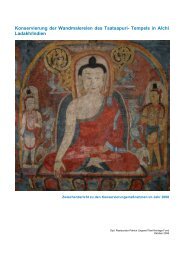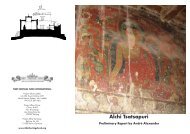Beijing Hutong Conservation Plan - Tibet Heritage Fund
Beijing Hutong Conservation Plan - Tibet Heritage Fund
Beijing Hutong Conservation Plan - Tibet Heritage Fund
You also want an ePaper? Increase the reach of your titles
YUMPU automatically turns print PDFs into web optimized ePapers that Google loves.
4.3 Survey results and analysis<br />
a) Occupancy and ownership<br />
a-1. Population<br />
<strong>Beijing</strong> has 13.6 million permanent residents and an additional floating population of 3.8 million. According to our survey data, around 70% of residents in<br />
the Yandai and Gulou survey areas are original <strong>Beijing</strong> residents; in the Chaodou area only 55% are from <strong>Beijing</strong>. In the Chaodou area, many courtyards<br />
belong to work-units that house their employees, many who come from other parts of China.<br />
60% of the residents in the surveyed areas have lived in their homes for more than 30 years (i.e. since the Cultural Revolution), and their off-spring are still<br />
living with them or nearby. This shows that the area’s residents have formed a comparatively deep-rooted community. Because of the deep social changes<br />
and upheavals in China during the Cultural Revolution it is rare to find a family still inhabiting their ancestral home anywhere in urban China. A residential<br />
community that has developed over the past three decades is therefore a healthy development for <strong>Beijing</strong>, and the community should be spared from new<br />
uprooting. Preservation of the community is an important aspect of the preservation of the historic buildings.<br />
a-2. Living space<br />
In the three surveyed areas, the average living inner space per residential unit, which<br />
we define as family, is two rooms (around 15m 2 ), with each family consisting of an<br />
average of 3.5 members. The living space per person here is much less than China’s<br />
official average of 20.23m 2 per person, and also still far from the ‘’Xiao Khang’’<br />
(modest wealth) standard of 12m 2 living space per person.<br />
In the Chaodou area, the residential space is larger, there are on average three rooms<br />
per family. The other two areas with their higher density are suffering from the frequent<br />
problem of overcrowding within a courtyard. To increase the available space per family<br />
unit will be a key factor for achieving successful rehabilitation.<br />
A kitchen set up in extention<br />
building<br />
Children make homework<br />
at courtyard<br />
33




